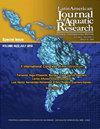De Novo assembly and annotation of the Pacific calico scallop (Argopecten ventricosus) transcriptome for immune-related gene discovery
IF 0.8
4区 农林科学
Q3 FISHERIES
Latin American Journal of Aquatic Research
Pub Date : 2022-05-01
DOI:10.3856/vol50-issue2-fulltext-2705
引用次数: 1
Abstract
Invertebrates' immune defense mechanisms play a critical role in pathogen recognition and elimination. De novo assembly and annotation of the Argopecten ventricosus transcriptome were performed for the immune-related gene identification. Scallops (height: 4.4 cm) were challenged with inactivated Vibrio parahaemolyticus IPNGS16. The RNA from different tissues was pooled for a single cDNA library construction sequenced by NextSeq 500 platform 2×75 paired‐end chemistry. Before de novo assembling with Trinity, reads were analyzed with FastQC, Trimmomatic, and Prinseq. Assembled sequences were analyzed by CD-HIT-EST and TransDecoder. The corresponding annotation was performed against NCBI-nr, RefSeq protein, and KAAS (KEGG) databases. The Trinity assembly yielded 107,516 contigs. TransDecoder yielded 25,285 sequences as CDSs of which, 16,123 were annotated against the NCBI-nr protein, most of them scored with Crassostrea gigas data. Gene ontology mapped sequences (15,262) were classified in molecular functions (~13,000), cellular components (~11,000), and biological processes (~13,000). The KAAS analysis showed biological categories for metabolism (13%), cellular processes (12%), genetic information processing (10%), organismal systems (19%), environmental information (13%), and human diseases (33 %). Within the organismal systems, 467 immune-related genes (KO) were identified. Sixty-four immune-related genes were annotated/blasted against the NCBI-nr and RefSeq protein databases. An RT-qPCR was performed to analyze the expression level of immune-related genes obtained in the transcriptome analysis in scallops (height 4.5 cm) treated with probiotic bacilli added to culture water. Bacilli significantly increased the expression of the HSP70 and PGRP genes. The gene transcripts analysis of A. ventricosus will better understand its immune response against pathogens in culture systems.用于免疫相关基因发现的太平洋扇贝转录组的De Novo组装和注释
无脊椎动物的免疫防御机制在病原体识别和消除中起着至关重要的作用。对心室镜转录组进行了从头组装和注释,用于免疫相关基因鉴定。用灭活的副溶血性弧菌IPNGS16攻击扇贝(高度:4.4cm)。将来自不同组织的RNA合并用于单个cDNA文库构建,通过NextSeq 500平台2×75配对末端化学测序。在与Trinity重新组装之前,用FastQC、Trimmomatic和Prinseq分析读数。通过CD-HIT-EST和TransDecoder对组装的序列进行分析。针对NCBI nr、RefSeq蛋白和KAAS(KEGG)数据库进行相应的注释。三一组合产生107516个重叠群。TransDecoder产生了25285个序列作为CDSs,其中16123个是针对NCBI nr蛋白注释的,其中大多数是用Crassostrea gigas数据评分的。基因本体映射序列(15262)分为分子功能(~13000)、细胞成分(~11000)和生物过程(~113000)。KAAS分析显示,代谢(13%)、细胞过程(12%)、遗传信息处理(10%)、组织系统(19%)、环境信息(13%)和人类疾病(33%)属于生物学类别。在生物体系统中,鉴定出467个免疫相关基因(KO)。64个免疫相关基因针对NCBI nr和RefSeq蛋白数据库进行了注释/爆破。进行RT-qPCR以分析在用添加到培养水中的益生菌杆菌处理的扇贝(高度4.5cm)的转录组分析中获得的免疫相关基因的表达水平。Bacilli显著增加HSP70和PGRP基因的表达。对A.ventricosus的基因转录本分析将更好地了解其在培养系统中对病原体的免疫反应。
本文章由计算机程序翻译,如有差异,请以英文原文为准。
求助全文
约1分钟内获得全文
求助全文
来源期刊

Latin American Journal of Aquatic Research
FISHERIES-MARINE & FRESHWATER BIOLOGY
CiteScore
1.70
自引率
10.00%
发文量
44
审稿时长
4-8 weeks
期刊介绍:
Latin American Journal of Aquatic Research- LAJAR is the continuation of the journal Investigaciones Marinas (1970-2007) and is published since 2008 by the Escuela de Ciencias del Mar, Facultad de Ciencias del Mar y Geografía of the Pontificia Universidad Católica de Valparaíso. LAJAR is an “Open Access” journal that publishes in English language, original research articles, reviews and short communications on aquatic science, which contain the results of research conducted in aquaculture or in oceanic and coastal marine waters of Latin America.
The following topics are considered: Physical Oceanography, Chemical Oceanography, Marine Biogeochemistry, Marine Pollution and Toxicology, Marine Geology and Geophysics, Biological Oceanography, Fisheries and Aquaculture.
 求助内容:
求助内容: 应助结果提醒方式:
应助结果提醒方式:


